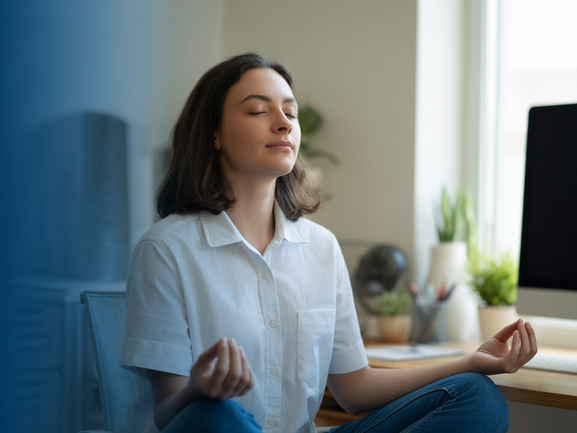7 Essential Meditation and Mindfulness Tips for Remote Workers: Transform Your Home Office Experience
Working from home has become the new normal for millions of professionals worldwide. However, remote work brings unique challenges that can significantly impact mental health and productivity. Studies show that 67% of remote workers struggle with loneliness, while 38% report increased difficulty concentrating at home.
The good news? Meditation and mindfulness practices can transform your home office experience, helping you manage stress, enhance focus, and create better work-life boundaries. Moreover, implementing these techniques doesn’t require hours of practice – just a few minutes daily can make a remarkable difference.
Let’s explore seven powerful meditation strategies specifically designed for remote workers, along with practical tips you can implement immediately.
1. Master the 5-Minute Meditation Break
The most effective way to maintain focus throughout your workday is through short meditation breaks. Instead of scrolling social media during breaks, try this simple technique:
- Set a timer for 5 minutes
- Close your eyes and focus on your breathing
- Count each inhale and exhale up to 10, then start over
- When thoughts arise, gently return attention to your breath
Research from Harvard Business Review indicates that employees who take regular meditation breaks show 28% better stress management and 20% improved decision-making abilities.
2. Create a Mindful Workspace Environment
Your physical environment significantly impacts your mental state. Transform your home office into a mindful workspace by:
- Decluttering your desk to reduce visual distractions
- Adding plants or natural elements to promote calmness
- Using soft, natural lighting instead of harsh fluorescents
- Designating a specific area for brief meditation sessions
Furthermore, consider incorporating aromatherapy with essential oils like lavender or eucalyptus to enhance your workspace’s calming atmosphere.
3. Practice Breathing Techniques for Instant Stress Relief
When deadline pressure mounts, breathing techniques provide immediate relief. Try the 4-7-8 method:
- Inhale through your nose for 4 counts
- Hold your breath for 7 counts
- Exhale through your mouth for 8 counts
- Repeat 3-4 times for optimal results
This technique activates your parasympathetic nervous system, naturally reducing cortisol levels and promoting relaxation. Additionally, you can practice this discreetly during video calls or between meetings.
4. Establish Mindful Transitions Between Work and Personal Time
One of the biggest challenges in remote work is creating clear boundaries. Develop a mindful transition ritual:
- Take three deep breaths before starting work
- Set clear intentions for your workday
- Create an “end of workday” routine with 10 minutes of reflection
- Practice gratitude for three things that went well
These transitions help your brain shift between work and personal modes, preventing burnout and improving overall well-being.
5. Implement Digital Detox Practices
Constant notifications and screen time contribute significantly to work-from-home stress. Incorporate these digital detox practices:
- Turn off non-essential notifications during focused work periods
- Use the “Do Not Disturb” mode for 30-minute deep work sessions
- Take hourly breaks away from all screens
- Practice the 20-20-20 rule: every 20 minutes, look at something 20 feet away for 20 seconds
Research from the American Psychological Association shows that excessive screen time increases anxiety levels by 35% in remote workers.
6. Body Scan Meditation for Desk Workers
Prolonged sitting creates physical tension that affects mental clarity. Body scan meditation helps release this tension:
- Sit comfortably in your chair with feet flat on the floor
- Close your eyes and take three deep breaths
- Start from the top of your head, slowly scanning down
- Notice areas of tension without trying to change them
- Breathe into tense areas and visualize them relaxing
- Continue down to your toes, spending 10-15 minutes total
This practice not only reduces physical discomfort but also improves body awareness, helping you maintain better posture throughout the day.
7. Develop a Gratitude Practice for Remote Workers
Isolation and routine can lead to negative thinking patterns. Combat this with a structured gratitude practice:
- Keep a gratitude journal beside your workspace
- Write down three work-related positive experiences daily
- Include personal gratitudes that balance work stress
- Share appreciation with colleagues through messages or calls
Studies indicate that regular gratitude practice increases productivity by 31% and reduces stress-related symptoms by 23%.
Integrating Technology for Better Results
While mindfulness emphasizes present-moment awareness, technology can enhance your practice. Consider using apps and platforms designed specifically for remote workers’ needs.
Vitalizen.app offers guided meditations specifically designed for professionals, including sessions for concentration, stress relief, and work-life balance. The platform understands the unique challenges of remote work and provides targeted solutions.
Frequently Asked Questions
How long should I meditate as a remote worker?
Start with 5-10 minutes daily and gradually increase. Even 2-3 minutes between meetings can be beneficial. Consistency matters more than duration.
Can I meditate during video calls?
<div itemscope itemprop=”acceptedAnswer” itemtype=”https://schema.

